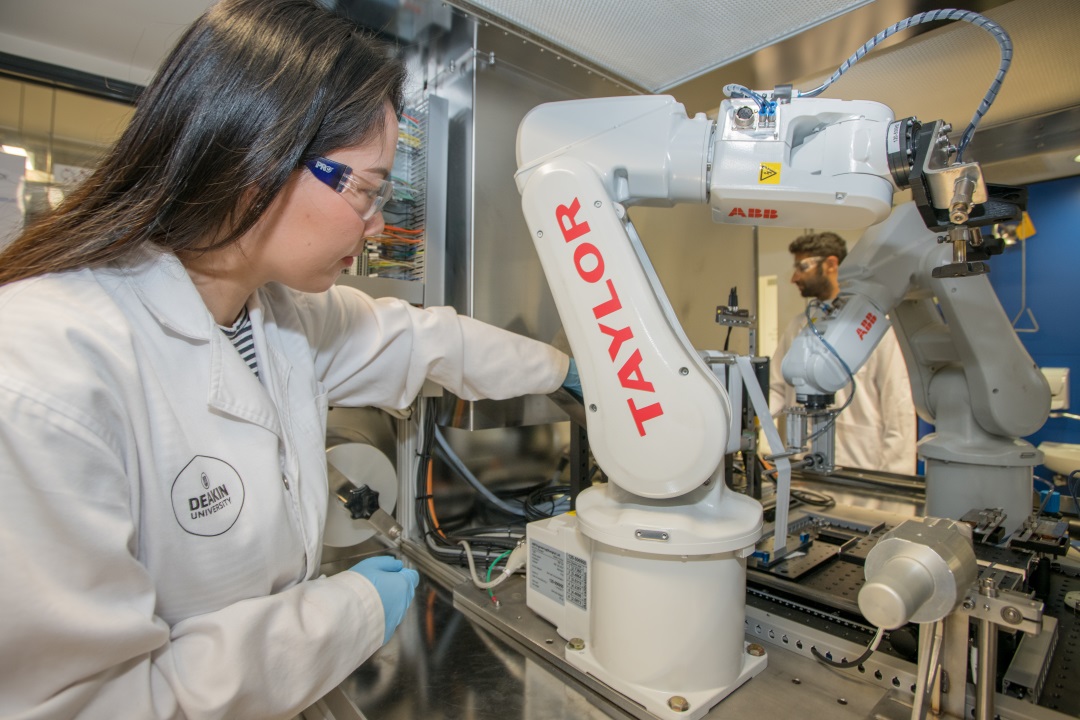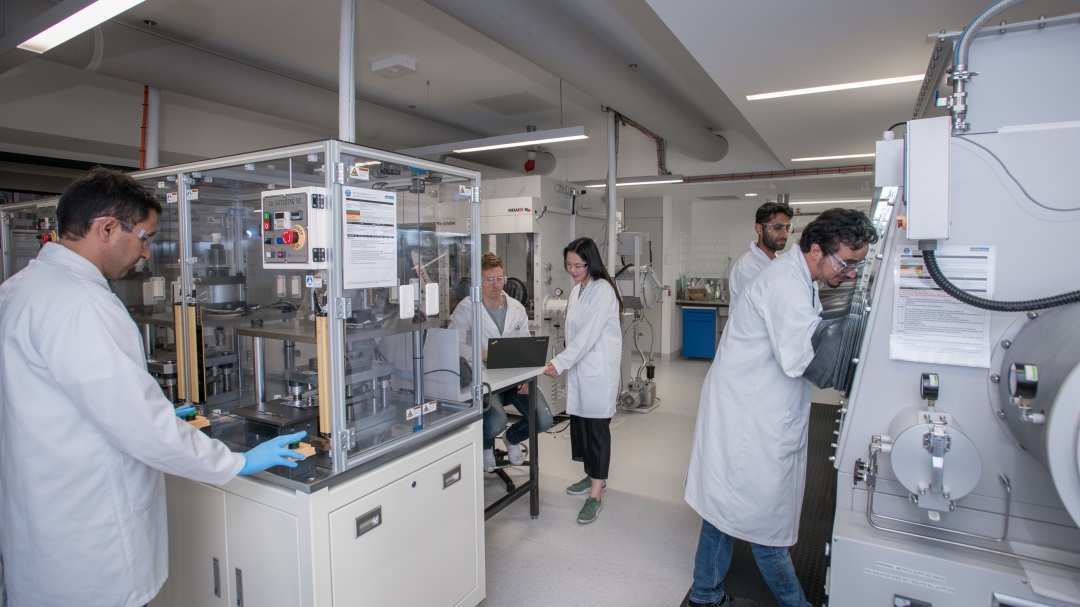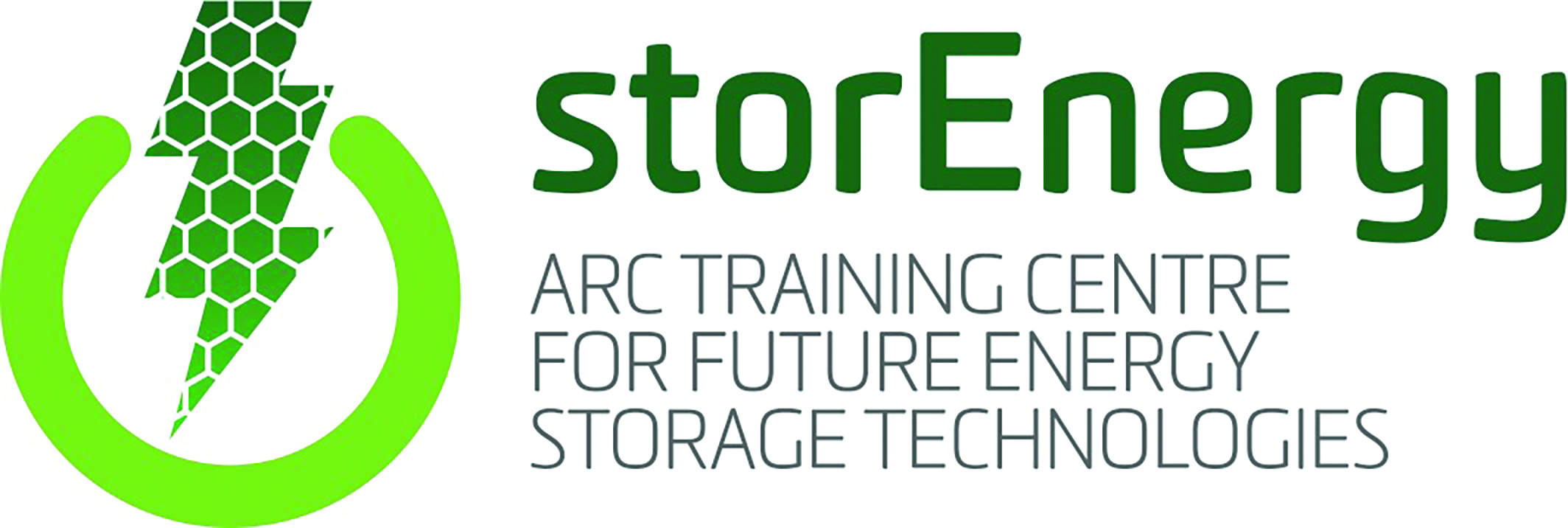Energy storage in the 21st century
In recent decades, however, it has become increasingly obvious that we need to move away from traditional methods of producing energy towards renewable sources such as solar or wind power. Burning fossil fuels like oil, coal and gas to power our world contributes to climate change through the release of carbon dioxide, the primary greenhouse gas emitted through human activities.
In the transport sector, for example, there is a push towards vehicles powered by electric motors, rather than traditional combustion engines that burn petrol or diesel (both of which are derived from oil). But this and renewable energy sources bring challenges – most notably, the need to store large amounts of energy in batteries.
It is challenges such as these that Dr Jenny Pringle, an associate professor based at Deakin University’s Institute for Frontier Materials, and her colleagues are hoping to address. She is working on developing new organic ionic electrolytes – both liquid and solid – for electrochemical devices. And she’s collaborating with research teams at storEnergy to find out how to successfully implement these electrolytes.
WHAT ARE ELECTROCHEMICAL DEVICES AND ELECTROLYTES?
Electrochemical devices are devices that either use electrical energy to cause chemical reactions that would otherwise not occur (for example, decomposition of a stable chemical) or generate electricity from a chemical reaction (like batteries). Invented by Italian physicist Alessandro Volta in 1800, the basic workings of the battery has remained the same for centuries, even though the technology has changed enormously: Two electrodes made of different types of metal are separated by a conductive electrolyte, a solution that conducts – i.e. allows the movement of –electrically-charged particles known as ions.
Since the invention of Volta’s battery, materials scientists and chemists like Jenny and others working at storEnergy have experimented with different electrodes, changed the chemistry of the electrolyte solutions and developed new ways of constructing the batteries. These days, the most commonly used rechargeable batteries are based on lithium-ion technology, and power everything from the batteries in cell phones to the battery packs in electric vehicles.
WHY ARE BATTERIES BECOMING MORE IMPORTANT?
In addition to powering devices, batteries are increasingly used to help cope with differences in electrical demand and electrical production. For example, solar panels only produce electricity when the sun is shining, but not necessarily when it is most wanted. By contrast, a fossil-fuel powered power station can produce electricity whenever it is needed and can increase or decrease electricity production at times of high or low demand. Matching electricity production to demand is one of the major obstacles facing renewable energy.
By connecting a rechargeable battery to a solar panel, however, the electricity produced when the sun is shining can be stored and used when it is needed, making alternative energy sources to fossil fuels more practical. A solar-powered garden light is a common example of this, but greater numbers of households and businesses are using high-capacity batteries to store the electricity generated from solar panels during the day. In the future, it is hoped that entire communities or even countries might use batteries to help them move towards more sustainable ways of generating electricity.
HOW WILL BATTERIES NEED TO IMPROVE TO HELP ACHIEVE THIS GOAL?
Despite the huge advances in battery technology in recent decades, much more needs to be done. Challenges to overcome include:
Extending a battery’s life
A battery’s life can be described as a measure of its performance or longevity, i.e. how long a battery lasts after charging before it needs to be recharged again. From short battery lives in mobile phones and laptops to “range anxiety” in electric cars (this is when drivers worry about how long they have until their car runs out of power, and whether they can make it to a charging point), extending battery life is a challenge. Simply using a larger battery is not always practical or affordable, so another way to solve this problem is to increase the energy density of the battery – that is the amount of electricity that can be stored per kilogram of battery.
Impact on the environment
Reference
https://doi.org/10.33424/FUTURUM33
In recent decades, however, it has become increasingly obvious that we need to move away from traditional methods of producing energy towards renewable sources such as solar or wind power. Burning fossil fuels like oil, coal and gas to power our world contributes to climate change through the release of carbon dioxide, the primary greenhouse gas emitted through human activities.
In the transport sector, for example, there is a push towards vehicles powered by electric motors, rather than traditional combustion engines that burn petrol or diesel (both of which are derived from oil). But this and renewable energy sources bring challenges – most notably, the need to store large amounts of energy in batteries.
It is challenges such as these that Dr Jenny Pringle, an associate professor based at Deakin University’s Institute for Frontier Materials, and her colleagues are hoping to address. She is working on developing new organic ionic electrolytes – both liquid and solid – for electrochemical devices. And she’s collaborating with research teams at storEnergy to find out how to successfully implement these electrolytes.
WHAT ARE ELECTROCHEMICAL DEVICES AND ELECTROLYTES?
Electrochemical devices are devices that either use electrical energy to cause chemical reactions that would otherwise not occur (for example, decomposition of a stable chemical) or generate electricity from a chemical reaction (like batteries). Invented by Italian physicist Alessandro Volta in 1800, the basic workings of the battery has remained the same for centuries, even though the technology has changed enormously: Two electrodes made of different types of metal are separated by a conductive electrolyte, a solution that conducts – i.e. allows the movement of –electrically-charged particles known as ions.
Since the invention of Volta’s battery, materials scientists and chemists like Jenny and others working at storEnergy have experimented with different electrodes, changed the chemistry of the electrolyte solutions and developed new ways of constructing the batteries. These days, the most commonly used rechargeable batteries are based on lithium-ion technology, and power everything from the batteries in cell phones to the battery packs in electric vehicles.
WHY ARE BATTERIES BECOMING MORE IMPORTANT?
In addition to powering devices, batteries are increasingly used to help cope with differences in electrical demand and electrical production. For example, solar panels only produce electricity when the sun is shining, but not necessarily when it is most wanted. By contrast, a fossil-fuel powered power station can produce electricity whenever it is needed and can increase or decrease electricity production at times of high or low demand. Matching electricity production to demand is one of the major obstacles facing renewable energy.
By connecting a rechargeable battery to a solar panel, however, the electricity produced when the sun is shining can be stored and used when it is needed, making alternative energy sources to fossil fuels more practical. A solar-powered garden light is a common example of this, but greater numbers of households and businesses are using high-capacity batteries to store the electricity generated from solar panels during the day. In the future, it is hoped that entire communities or even countries might use batteries to help them move towards more sustainable ways of generating electricity.
HOW WILL BATTERIES NEED TO IMPROVE TO HELP ACHIEVE THIS GOAL?
Despite the huge advances in battery technology in recent decades, much more needs to be done. Challenges to overcome include:
Extending a battery’s life
A battery’s life can be described as a measure of its performance or longevity, i.e. how long a battery lasts after charging before it needs to be recharged again. From short battery lives in mobile phones and laptops to “range anxiety” in electric cars (this is when drivers worry about how long they have until their car runs out of power, and whether they can make it to a charging point), extending battery life is a challenge. Simply using a larger battery is not always practical or affordable, so another way to solve this problem is to increase the energy density of the battery – that is the amount of electricity that can be stored per kilogram of battery.
Impact on the environment
Safety
“There have been many news stories recently about lithium-ion batteries catching fire, especially when they are being charged,” says Jenny. “The electrolytes currently being used in these devices are flammable and volatile, and give off toxic fumes when they burn.” With this in mind, Jenny and her colleagues are looking for unique alternatives that are safer and more reliable.
Cost
Batteries can be expensive. Certainly, the batteries needed for electric or hybrid electric vehicles cost significantly more than those used in traditional petrol or diesel-powered cars.
WHAT IS THE GOAL OF JENNY’S RESEARCH?
Working at the fundamental chemistry end of battery production, Jenny’s interest lies in developing liquid and solid electrolytes. “Ultimately, we would like to be able to develop batteries that get away from lithium by using sodium, for example, which can be much cheaper and more abundant,” she explains. “Or we would like to use lithium as lithium metal instead of lithium ion so that we get much more energy from the batteries.”
Excitingly, this research is being tested at a battery prototyping facility called BatTRI-Hub, although much work still needs to be done. Making solid electrolytes that allow the charged particles (ions) to move quickly enough through the material is difficult, but very much needed if they are to be used in high-powered batteries.
“Energy storage is such an important area of research – from developing safer and more sustainable batteries for personal use, to making massive scale, stationary batteries to support renewable energy from solar and wind farms,” says Jenny. Indeed, it is becoming increasingly vital that we move to more sustainable and environmentally-friendly methods of producing the energy. And battery storage is certainly a viable option. As such, materials science is a growth industry and likely to continue to be so in the future. If you want a challenging career that will impact the lives of everyone, as well as help fight one of the biggest technological challenges facing the human race today, then this is the field for you.
 PROF JENNY PRINGLE
PROF JENNY PRINGLEInstitute for Frontier Materials
Deakin University, Australia
FIELD OF RESEARCH: Materials Science and Chemistry
Jenny and her team are researching and developing new liquid and solid organic ionic electrolytes for use in batteries. Their hope is to find a way of replacing the traditional lithium-ion technology used in rechargeable batteries with safer and better alternatives.
FUNDER: Australian Research Council
 PROF JENNY PRINGLE
PROF JENNY PRINGLEInstitute for Frontier Materials
Deakin University, Australia
FIELD OF RESEARCH: Materials Science and Chemistry
Jenny and her team are researching and developing new liquid and solid organic ionic electrolytes for use in batteries. Their hope is to find a way of replacing the traditional lithium-ion technology used in rechargeable batteries with safer and better alternatives.
FUNDER: Australian Research Council
WHAT DID YOU WANT TO BE WHEN YOU WERE YOUNGER?
Honestly, I never really had an aim to “be” anything in particular. Which is OK, I think, as probably half the jobs that exist now hadn’t been invented when I was young. I just did what I enjoyed and was OK at during school, which was chemistry, but I also enjoyed writing and had a good imagination. Now I get to use all those attributes, so I’m really lucky.
HOW DID YOU GET INVOLVED IN BATTERY TECHNOLOGIES?
That’s a relatively recent move for me. I have been interested in ionic liquids for nearly 20 years, and these can be used as solvents for many different things. They can be used in synthesis, for separation, for biological applications, for dissolving biomass (waste plant material) or to make renewable fuels. I find all of these applications interesting.
So, I started my research career in Australia working at the Centre for Green Chemistry (at Monash University) with Prof Doug MacFarlane, who is Deputy Director at storEnergy. It was through working with Prof Maria Forsyth and Prof Patrick Howlett, who is also at storEnergy and BatTRI-Hub, that I got more involved in batteries. They have teams that can take the solid or liquid ionic materials that I make and really understand how good they are for different batteries and why.
IN YOUR EXPERIENCE, IS MATERIALS SCIENCE A MALE-DOMINATED FIELD?
Well, my supervisor (Maria) is female, and she has always been an inspiration. Certainly, by the time you get to the senior level there are more men than women – at the PhD level the numbers are more even. But things are changing, with a lot more support available to help with things like parental leave, part-time positions and career development opportunities specifically for women, etc. So, I’d urge anyone who is interested in doing materials science not to be put off by this as there are many people working toward making it a lot more equitable. And the more women there are who work in the field, hopefully the better the situation will get. At the end of the day, I think that it is about finding the right team (male and female) to work with. Surround yourself with people who inspire you and science that excites you – that’s what is important.
01 Find areas that interest and motivate you – and just as importantly, identify those that don’t.
02 Energy will always be hugely important all over the world. Being well-trained in the underlying science will make you a strong candidate for whatever direction you decide to take later.
03 Get experience as early as possible. For example, look for summer jobs in universities or industry.
Based in Australia, and partly funded by the Australian Research Council, storEnergy (also known as the ARC Training Centre for Future Energy Storage Technologies) is a partnership between five universities, government and industry. Led by Prof Maria Forsyth, storEnergy’s ultimate goal is to train and skill the next generation of workers within the energy sector. Jenny and her team at Deakin University are just one of several groups working on projects associated with storEnergy.
The training centre is involved in a number of exciting research projects. These include:
- Battery recycling, battery re-use and finding new uses for existing batteries.
- Ensuring batteries are safe, particularly in demanding environments (underwater, desert conditions, arctic conditions)..
- Developing specialised batteries for electric vehicles, the defence industry, electricity grids and mining equipment.
- Developing smart battery management systems to monitor batteries whilst they are being used, to improve reliability and safety.
“Our aim is to collaborate on many different aspects of energy storage – everything from the quite fundamental chemistry and materials research required for new electrolytes and electrodes (that’s where I come in), through the development of different kinds of batteries and supercapacitors, right up to working with companies on how to use these devices in their applications,” says Jenny. “These applications include unmanned aerial vehicles (i.e. drones), sensors, and the technologies required for the transmission of electricity.”
• storEnergy provides training in research, technical skills, communication, graphics and scientific writing to PhD students. Another key component of the training is a one-year industry placement.
• PhD students from a range of academic backgrounds are welcome, including chemistry, materials or electrical engineering, physics, etc.
• Even though its training facilities are aimed at PhD students, storEnergy offers short-term placements to Master’s students, including from overseas; opportunities for Honours degree projects, and summer placements for undergraduates in their third year.
• Jenny recommends writing to storEnergy, explaining your background and interests, to find out if the training centre can offer any
opportunities for you. https://www.storenergy.com.au
 MEET PROF MARIA FORSYTH
MEET PROF MARIA FORSYTH
Maria is the Director of storEnergy, Associate Director of the Institute for Frontier Materials, Deakin University and Co-Director of BatTRI-Hub “I believe that our world needs to urgently shift from fossil fuel-based energy to cleaner, more sustainable sources. While wind and solar technologies are well established and highly affordable, we need to have mechanisms in place to store the energy produced. We also need to consider technologies’ life cycles so that today’s solutions for issues like climate change don’t become tomorrow’s environmental disasters.
“A career in energy storage can be anything from materials design and synthesis for new, improved technologies to prototyping these materials into batteries and integrating them into real-world applications. It is an exciting field to contribute to!”
 MEET PROF MARIA FORSYTH
MEET PROF MARIA FORSYTH
Maria is the Director of storEnergy, Associate Director of the Institute for Frontier Materials, Deakin University and Co-Director of BatTRI-Hub “I believe that our world needs to urgently shift from fossil fuel-based energy to cleaner, more sustainable sources. While wind and solar technologies are well established and highly affordable, we need to have mechanisms in place to store the energy produced. We also need to consider technologies’ life cycles so that today’s solutions for issues like climate change don’t become tomorrow’s environmental disasters.
“A career in energy storage can be anything from materials design and synthesis for new, improved technologies to prototyping these materials into batteries and integrating them into real-world applications. It is an exciting field to contribute to!”
01 Take a look at the Master’s courses on offer around the world to give you a flavour of this field.
02 If you want to study for a PhD, pick something that allows you to broaden your experiences in the lab AND with respect to policy and industry. Your studies may lead to a role in academia, industry or government. The possibilities are vast and will depend on your interests and passions.
 MEET ANNA WARRINGTON
MEET ANNA WARRINGTON
Anna is a PhD student from the UK who is working with Jenny at Deakin University. We ask her what she enjoys most about her studies in chemistry.
“Chemistry is a very creative and unpredictable field. From synthesising a starting material for a new anti-cancer drug to recycling lanthanide metals in your phone, chemistry applies to just about anything. I enjoy working on a project that will improve the world around me and test my own ideas. By studying chemistry, not only am I learning a lot of skills such as analytical, problem-solving and communication skills, but also how to link ideas together from completely different areas of chemistry to understand new concepts.”
QUALIFICATIONS: A Level maths, biology and chemistry; BSc in chemistry; MSc in chemistry
PhD PROJECT: Anna is using techniques developed for the pharmaceutical industry to produce the electrolytes in batteries more cheaply and in a more environmentally sustainable way.
 MEET ANNA WARRINGTON
MEET ANNA WARRINGTON
Anna is a PhD student from the UK who is working with Jenny at Deakin University. We ask her what she enjoys most about her studies in chemistry.
“Chemistry is a very creative and unpredictable field. From synthesising a starting material for a new anti-cancer drug to recycling lanthanide metals in your phone, chemistry applies to just about anything. I enjoy working on a project that will improve the world around me and test my own ideas. By studying chemistry, not only am I learning a lot of skills such as analytical, problem-solving and communication skills, but also how to link ideas together from completely different areas of chemistry to understand new concepts.”
QUALIFICATIONS: A Level maths, biology and chemistry; BSc in chemistry; MSc in chemistry
PhD PROJECT: Anna is using techniques developed for the pharmaceutical industry to produce the electrolytes in batteries more cheaply and in a more environmentally sustainable way.








I am a PhD student at NM-AIST public university in Tanzania, I am interested in energy materials and I want to come to your university for sandwich for laboratory experimentation and collaboration with you. May you send me your communications emails and skip for further communication?